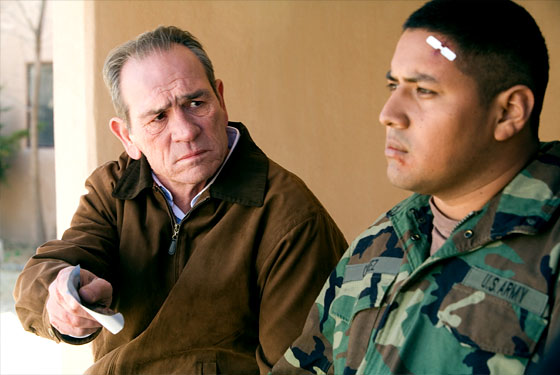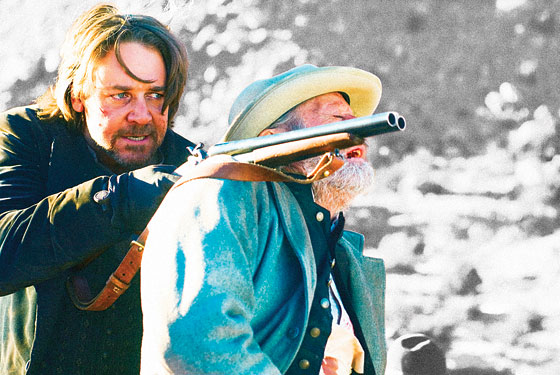
Paul Haggis’s In the Valley of Elah is vital in spite of its mustiness. As a narrative, it’s clunky. As a whodunit, it’s third-rate. As the drama of a closed-off man’s awakening, it’s predictable. But Haggis has got hold of a fiercely urgent subject: the moral devastation of American soldiers serving in (and coming home from) Iraq. At its heart are deeper mysteries—and a tragedy that reaches far beyond anything onscreen.
Tommy Lee Jones is in nearly every frame. He plays Hank Deerfield, a retired sergeant (and career Army man) who drives his pickup to a far-off base to investigate the disappearance of his only surviving son, Mike, just back from the Middle East. Mike’s buddies have no clue where he is—they say he must be holed up with a hot babe. The military authorities know nothing. The local police—including Charlize Theron as a harried detective—shrug him off: It’s an Army matter. Do any of these people want to know what’s happening? Maybe not. There is a house of cards to maintain.
The first scene of Haggis’s Crash made the point that racism is a very bad thing. So did the second. Ditto the third, fourth—and every one that followed. It’s a point with which I vigorously concur, but the film was so ham-handed that the people seemed like puppets. The good news is that Valley is relatively restrained—it’s every other scene that makes the same point, and only fleetingly. Over radios and TVs come snatches of news—an engagement in Fallujah, a presidential assurance of progress. Everything—and everyone—seems faraway, a little stuporous. The palette is washed out—khaki, military green—but shadowed. The vistas are empty. The tone is both vague and corrosive.
Jones is the perfect mascot for Haggis: a minimalist. The actor has a rep as a mean cuss, but like another mean cuss, Russell Crowe, in front of the camera he’s soft—his eyes are liquid and melancholy, his face is so pitted and riven with scowl lines he’s almost porous. He doesn’t need words—but when he has them, they’re sighed in his patented mixture of vinegar and regret. When Theron’s detective drives him to an off-limits crime scene and says, “It’s the least I could do,” he says, “I’d say that’s accurate”—offhand but shaming. Later, she tells him he doesn’t have to prove his love for his son, and his only response is to cock his head quizzically. His devastated wife (Susan Sarandon) has blurted that in their family, a son who didn’t fight wouldn’t have been a man. Hank knows a father who couldn’t face up to that wouldn’t be a man, either.
Hank, once an M.P., is a better detective than the cops or the Army’s investigator (Jason Patric), but there’s an especially wheezy contrivance: Mike’s PDA was damaged, and the techie who’s recovering the videos he took in Iraq is, wouldn’t you know, way busy and can only restore and e-mail them one at a time—each piece of the puzzle arriving at a strategic moment in the plot. But the fractured, hazy images on that small screen are chilling—from Mike tossing liberated Iraqi kids their first football (they run away with it) to things much worse. They echo what too few of us have seen in documentaries like The War Tapes (composed of videos taken by reservists) and in accounts from places like Haditha.
In the Valley of Elah is a movie about Iraq that could only have been made after Vietnam—after we’ve lived for three decades with its American casualties. Hank Deerfield was in Vietnam and still can’t believe what he sees. The movie’s only “Huh?” is that symbolic title, which refers to the place where David took on Goliath with a slingshot. Are the American soldiers or the Iraqis meant to be David? Or are the Davids the Americans at home—the ones who need to confront a ruthless and multi-tentacled administration? I’m stumped, but I forgive Haggis for overreaching. He must have thought he needed to invoke the Old Testament to say what he feels about a war that stinks to high heaven.
Fresh from their startling (if overpraised) and unbelievably brutal crime melodrama A History of Violence, David Cronenberg has reteamed with Viggo Mortensen for the startling and unbelievably brutal crime melodrama Eastern Promises. Mortensen again plays a man who is purposefully unreadable—the Russian driver for London-based Eastern European mobsters and a pal of the boss’s volatile son (Vincent Cassel). This time, his blonde co-star is Naomi Watts as a nurse-midwife who watches a pregnant 14-year-old Russian prostitute hemorrhage to death on the operating table and heads off with her diary in search of a translator. Wouldn’t you know she takes it to the absolute wrong person—the boss (Armin Mueller-Stahl) of the crime family that turns Eastern European girls into sex slaves? Will the ostensibly amoral Mortensen be her rescuer or assassin?

Mortensen is good in a role like this—a man who uses his chiseled, blue-eyed, dimpled handsomeness as a mask to hide his thoughts. It’s hard to know what else he might bring to a part—although when I first saw him, in a small role as a paraplegic in Carlito’s Way, I thought he’d be a major actor. His character here is nowhere near as layered as in A History of Violence, and neither is the movie. It’s engrossing, and Mueller-Stahl’s mix of Old World chivalry and murderousness is scarier than Jason and Freddy combined. But Eastern Promises is finally conventional, even sentimental—or as sentimental as a film in which a knife gets driven through someone’s eyeball into his brain in a gruelingly extended medium close-up can be. There’s nothing comparable to the mirror-image sex scenes between Mortensen and Maria Bello that anchored History—only a lot of Watts trudging back and forth with that damn diary-McGuffin.
The big gore set piece will get people buzzing, though. For his last film, Cronenberg brought something new to the fights: Mortensen didn’t just move faster than his antagonists; he came in way close and butted their heads and smashed their Adam’s apples and mashed their noses into their faces. He does all that here, too, but in a steam bath minus a towel. Cronenberg doesn’t just deliver bravura stabbing and bone-snappings and eye-gougings; he manages to keep the Mortensen-pickle shots to a minimum—and get his “R” rating. We wouldn’t want anything to upset the kids!
3:10 to Yuma, the second adaptation of a fifties Elmore Leonard short story (from back when he wrote oaters), has two things going for it. The first is simply its genre—and the nostalgia many of us feel for Westerns in which heroes struggle to cling to their ideals in a craven society. The second is Russell Crowe, normally an actor who disappears so far into his characters you’d swear his DNA has been altered. As Ben Wade, gang leader and murderer, he gives an ironic performance, but Crowe’s irony is more intense than other actors’ obsession. He turns the idea of having so few emotions—of being beyond caring—into a bloody joke. He upstages everyone with his laughing eyes.
Leonard’s story was basically two men—deputy and outlaw—in a hotel room waiting for a train to prison while the bad guy’s gang amasses in the street below, poised to save him from hanging. It still is, although the film, directed by James Mangold, carts in everyone from the family of the hero (Christian Bale) to an evil rancher (he wants the hero’s farm) to prostitutes to Chinese railroad builders to a Pinkerton man played by Peter Fonda—the onetime counterculture hero channeling, very amusingly, Clint Eastwood and John Wayne. The editing is tense and there’s mucho splatter but the climax is unforgivable for reasons I can’t spell out—and owes something to a recent picture I can’t name. As spoilers go, it would be a hanging offense.
What could impel Jodie Foster and director Neil Jordan to whisk us back to the bad old days of Death Wish and Ms. 45? Were their credit cards maxed out? Were their kneecaps about to be broken? In The Brave One, Foster plays a radio host who delivers meditative monologues about our precious but too-ephemeral metropolis, only to find her romantic notions of identity shattered along with her skull when she and her fiancé are mugged by sniggering predators in Central Park. After she recovers (in body if not soul), she can’t seem to leave her apartment without being set upon by rapists and murderers. Lucky the lady has a gun … Homicide detective Terrence Howard—an avid listener of her weird radio spiels—faces an ethical decision: bust her or let her do what the law won’t let him do—blast the scum off the face of the Earth. You probably think I’m oversimplifying—that Foster and Jordan are too thoughtful, artistically ambitious, and politically progressive to make a movie that would have Bernie Goetz rolling his eyes. But Foster’s feminist victimization complex seems to be looping around to meet Nixon and Agnew. Next she’ll be hunting Commies for the FBI.
How lucky people were in the sixties to have something to take their minds off a corrupt administration and an unjust war—to remind us what humans could aspire to and achieve if they just wanted badly enough to humiliate the Commies. In the Shadow of the Moon, directed by David Sington (and “presented” by Apollo enthusiast Ron Howard), recounts the space race with the Soviets that led to one small step for a man and one giant leap for mankind—and to many other small steps on the lunar surface before nasa closed the books on the moon. The movie has a lot of talking heads—just about everyone except Neil Armstrong, apparently unwilling to take this particular step. But they’re great heads, still lean, still touched by wonder, and far enough past youthful vanity that Buzz Aldrin can boast of being the second man to walk on the moon but the first to pee on it. In between, we see the liftoffs, the orbits, the “Earth rises” that still put a lump in your throat, and, maybe best of all, the view from just above the cratered landscape as Armstrong and Aldrin search for a boulderless place to plop down. The film goes chronologically—not year by year but stage by stage in the journey, so you get multiple points of view (and camera angles) on everything from the first sight of the home world to bouncing along the white, fine-grained surface with only one-sixth the gravity of Earth’s. I came out giddy, feeling lighter—by about five-sixths—than I did when I went in.

BACKSTORY
Neil Armstrong, arguably the most famous Apollo 11 astronaut, is noticeably absent from In the Shadow of the Moon and has a history of avoiding the press. “He didn’t give interviews. He just didn’t like being a novelty,” explained Ron Huston, Armstrong’s co-worker at the University of Cincinnati, to the Cincinnati Enquirer. Armstrong has been burned more than once: He sued Hallmark Cards in 1994 after it used a recording of his famous “one small step” quote on a Christmas ornament. And in 2005, he sued his longtime barber for selling locks of his hair for a reported $3,000. According to John Reznikoff, who bought the hair, “What you discard is discarded.”
In the Valley of Elah
Directed by Paul Haggis. Warner Independent. R.
Eastern Promises
Directed by David Cronenberg. Focus Features. R.
3:10 to Yuma
Directed by James Mangold. Lions Gate Films. R.
The Brave One
Directed by Neil Jordan. Warner Bros. R.
In the Shadow of the Moon
Directed by David Sington. ThinkFilm. PG.
E-mail: filmcritic@newyorkmag.com.
